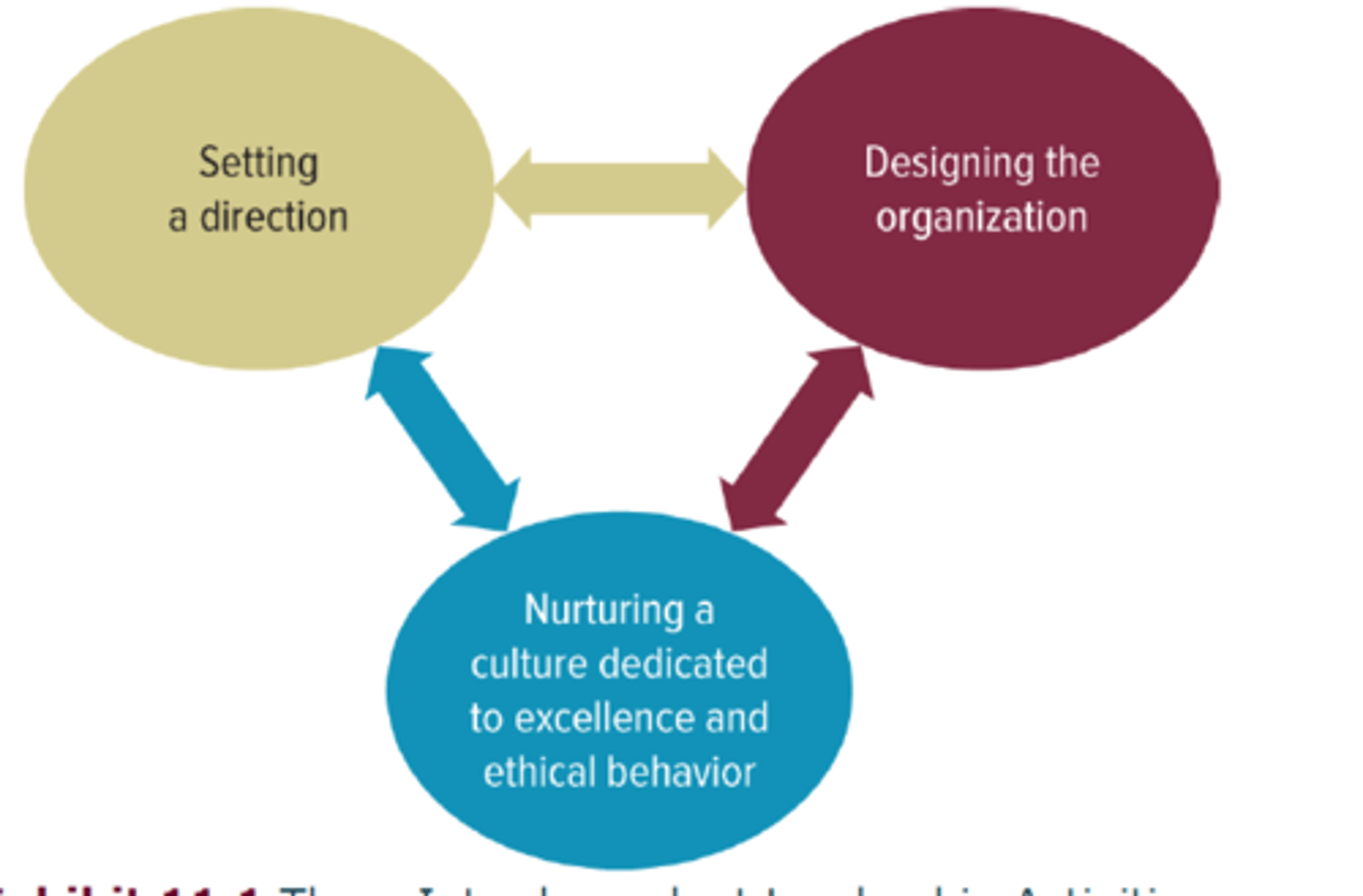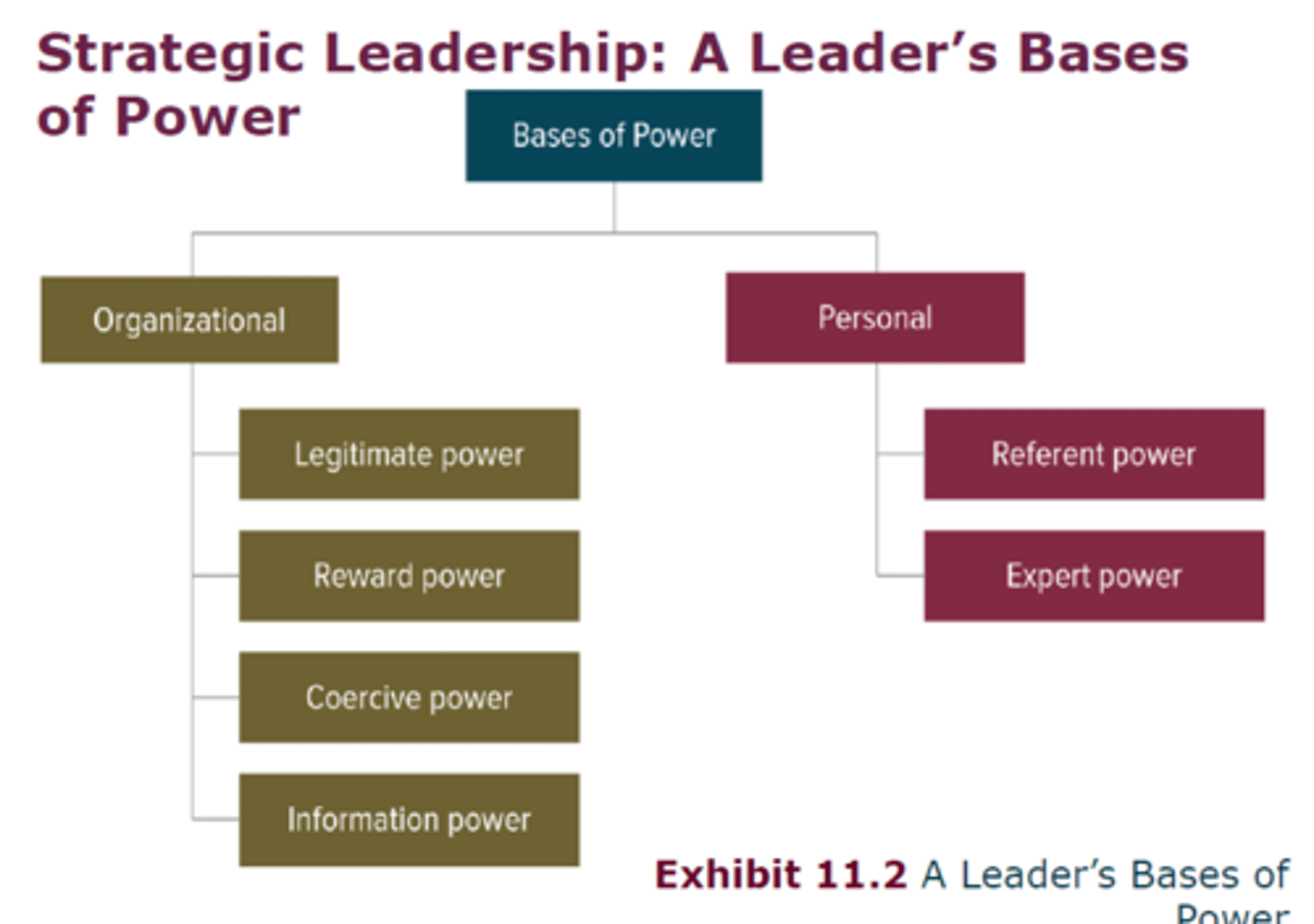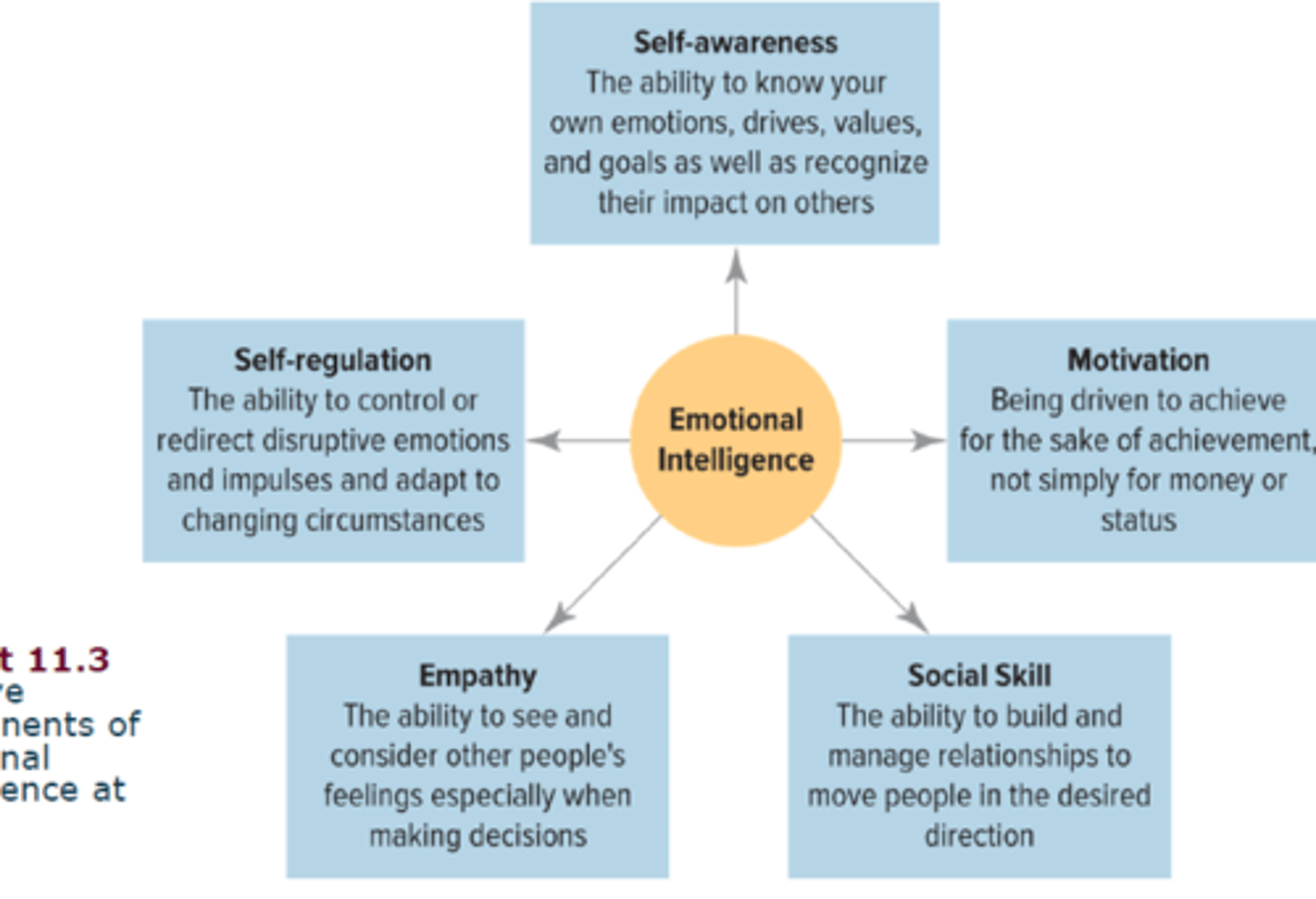Chapter 11- Strategic Leadership: Creating a learning organization and an Ethical organization
1/43
There's no tags or description
Looks like no tags are added yet.
Name | Mastery | Learn | Test | Matching | Spaced |
|---|
No study sessions yet.
44 Terms
what is strategic Leadership?
leadership is the process of transofming organizations from what they are to what the leader would have them become.
succesful leaders are:
proactive: dissatisfied with the status quo
goal oriented: visualizing successful futures
focused on the creation and implementation of a creative vision: understanding the process of bringing about change
what is the strategic leadership model

XYZ's CEO scrapped the company's commission-based reward system because it was rewarding employees for inappropriate behavior. This is an example of
A.setting a direction.
B.designing the organization.
C.unethical behavior.
D.failure to maintain the status quo.
B. designing the organization.
what are the three interdependent leadership activities:
1. setting a direction
2. designing the organization
3. nurturing a culture dedicated to excellence and ethical behavior
What does setting a direction involve in strategic leadership?
It involves scanning the environment for:
-All stakeholders
-Key trends and events (e.g., DEI)
Then forming a strategic vision that:
-Sets a clear future direction
-Provides a framework for mission and goals
-Enhances communication, participation, and commitment from employees
What does designing the organization require?
building mehanisms to implement the leaders vision and strategies through
- structures and teams
- systems and processes
what kind of problems can result from a lack of appropriate design?
- managers who don't understand their responsibilities
- reward systems that are not motivating
- inappropriate financial control systems
- insufficient integrating mechanisms
How do leaders nurture an excellent and ethical organizational culture?
Leaders must:
-Accept personal responsibility for ethical behavior
-Demonstrate that ethics are central to the firm's mission and vision
Reinforce ethics through:
-Role modeling
-Corporate credos and codes of conduct
-Reward systems, evaluations, policies, and procedures
leaders must overcome __________
barriers to change
Organizations are prone to inertia, slow to learn, adapt, and change because of:
•Vested interests in the status quo. (resistance to change)
•Systemic barriers. (organizational design flaws that block communication/innovation)
•Behavioral barriers. (biases formed from past experiences)
•Political barriers. (conflicts from power dynamics)
•Personal time constraints. (operational pressures that reduce time for strategic thinking)
what is power:
power is the leaders ability to influence others and overcome resistance
Leaders must make effective use of power to:
•Influence other people's behavior.
•Persuade them to do things they otherwise would not do.
•Overcome resistance and opposition.
what are the two sources of power?
Organizational power
Personal power

what are the types of organizational power?
legitimate power: based on formal authority
reward power: ability to grant rewards for positive outcomes
coercive power: ability to impose penalties
information power: control over critical info
what are the types of personal power?
expert power: based on knowledge and skills
referent power: based on admiration and loyalty
what are valuable traits of successful leaders?
- Technical skills (accounting, operations, research)
- cognitive abilities - analytical reasoning, quantitative analysis
-emotional intelligence- self management, managing relationships with others. (self-awareness, self-regulation, motivation, empathy, social skills)
what is emotional intelligence
EI refers to the ability to recognize, understand, and manage
one's own emotions and those of others.
It involves both intrapersonal and interpersonal intelligence.
what are the 5 components of emotional intelligence at work?
1. self awareness
2. motivation
3. social skills
4. empathy
5. self-regulation

effective leaders should...
•Have empathy for others.
•Be astute judges of people.
•Be passionate, persistent about pursuing valued objectives.
•Create personal connections with people, take time to engage employees individually and in groups.
effective leaders should NOT:
•Over-identify with others and make it difficult to make tough decisions.
•Become overly critical about shortcomings they perceive in others.
•Allow passion to close their minds to other possibilities.
•Make too many announced visits, creating a culture of fear and micromanagement.
Complete the following sentence. "Inspiring and motivating people with a mission or purpose are a ___________for developing an organization that can learn and adapt."
A. necessary and sufficient condition.
B. necessary, but not a sufficient condition.
C. goal, but not a necessary condition.
D. goal and a required pre-condition.
B. necessary, but not a sufficient condition.
What are the key traits of a learning organization in strategic leadership?
-A learning organization:
-Adapts to change
-Fosters creativity
-Questions basic assumptions and refreshes strategies
-Reengineers work processes
-Is reflective and asks probing questions to stay competitive
what are the 5 key elements of a learning organization?
1. Inspiring and motivating people with a mission or purpose
2. Empowering employees at all levels
3. accumulating and sharing internal knowledge
4. gathering and integrating external information
5. challenging the status quo and enabling creativity
Successful learning organizations motivate people with ________________
a mission or purpose
- create a proactive, creative approach to the unknown
- actively solicit the involvement of employees at all levels
- enables their employees to use their intelligence and apply their imagination
a learning environment involves
An organization-wide commitment to change
An action orientation, applicable tools & methods
How do successful learning organizations accumulate and share internal knowledge?
They build a culture that encourages:
-Employee involvement
-Widespread knowledge sharing
-Opportunity identification and experimentation
-Collaborative decision-making
-Sharing of best practices
They also use technology to support and enhance knowledge sharing.
How do successful learning organizations gather and integrate external information?
They recognize opportunities and threats by:
-Using multiple external sources (e.g., networks, alliances, competitor communication)
-Conducting competitive and functional benchmarking
-Asking customers for feedback and insights
How do successful learning organizations challenge the status quo and enable creativity?
Leaders drive useful change by:
-Creating a strong sense of urgency
-Establishing a culture of dissent
-Encouraging risk taking and learning from mistakes
-Formalizing forums for failure, shifting perspectives, involving outsiders, and aiming to disprove assumptions
What is the role of ethics in strategic leadership?
-Ethics is central to leadership and defines what is right and wrong
-Ethical beliefs stem from religion, culture, family, community, education, and peers
-Organizational ethics shape operating culture and acceptable behavior
Where do organizational ethical standards come from, and what supports unethical behavior?
Ethical behavior is influenced by the values, attitudes, and actions of leadership
Unethical practices often involve tacit or explicit cooperation of others within the organization
Why is a leader's ethical orientation important in promoting ethical behavior?
A leader’s integrity and ethical values:
-Shape behaviors across the organization
-Provide a common frame of reference
-Act as a unifying force
-Boost employee commitment and motivation
-Help create value and a competitive advantage
what are the ethical frameworks for integrity?
- compliance-based ehtics programs
- integrity based ethics programs
what is a compliance-based ethics program
one which prevents, detects, and punishes legal violations
what is an integrity-based ethics program?
one which enables ethical conduct
- examines organizational members core guiding values, thoughts, and actions
- defines responsibility and aspirations for ethical conduct
What are the key differences in ethos, objectives, and leadership between compliance-based and integrity-based ethics approaches?
Ethos:
Compliance-based: Conformity with external standards
Integrity-based: Self-governance by chosen standards
Objective:
Compliance-based: Prevent criminal misconduct
Integrity-based: Enable responsible conduct
Leadership:
Compliance-based: Led by legal office
Integrity-based: Led by management with input from staff
How do compliance-based and integrity-based approaches differ in methods and behavioral assumptions?
Methods:
Compliance-based: Reduced discretion, training, controls, audits, penalties
Integrity-based: Education, leadership, accountability, decision processes
Behavioral Assumptions:
Compliance-based: People are self-interested actors
Integrity-based: People are guided by values, ideals, and social expectations
What is the overall focus of compliance-based vs. integrity-based ethics management?
Compliance-based: Focus on rule-following and avoiding misconduct
Integrity-based: Focus on building ethical culture and empowering responsible behavior
Proactive measures to prevent organizational ethics problems include all of the following except
A.instituting a reward system which considers outcomes as its primary criterion.
B.using leaders as role models of ethical behavior.
C.issuing statements describing the organization's commitment to certain standards of behavior.
D.using the organization's information systems as a control system.
A. instituting a reward system which considers outcomes as its primary criterion.
What are the interrelated elements of a highly ethical organization?
-Ethical role models
-Corporate credos and codes of conduct
-Ethically-based reward and evaluation systems
-Consistently enforced ethical policies and procedures
what are key traits of ethical role models?
- must be consistent in their words and deeds
- their values and character must become transparent to an organization's employees
- they must take responsiblity for ethical lapses within the organization. (courageous behavior by leaders helps to strengthen an organization's ehtical environment)
What is the role of corporate credos and codes of conduct in an ethical organization?
They:
-Provide guidelines for norms, beliefs, and decision-making
-Clarify the organization’s stance on acceptable behavior
-Empower employees to refuse unethical acts
-Must be clearly communicated and known by all employees
How can reward and evaluation systems affect ethical behavior in an organization?
Support ethics by rewarding ethical thinking and behavior
-Align actions with words, follow through on commitments, admit mistakes
Undermine ethics by rewarding results regardless of methods
-Can lead to falsification of data under intense pressure or competition
How do policies and procedures support ethical behavior in an organization?
They guide ethical behavior by:
-Defining proper customer and supplier relationships
-Using global sourcing guidelines to avoid conflicts of interest
-Encouraging ethical conduct
-Ensuring communication, enforcement, and monitoring
-Supporting strong corporate governance